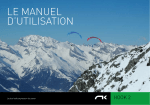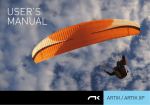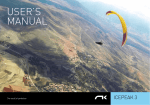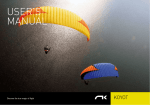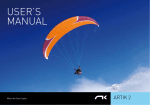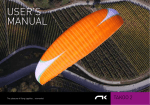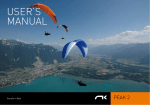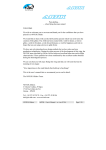Download USER'S MANUAL
Transcript
USER’S MANUAL Why Dream? HOOK 2 WELCOME We would like to welcome you to our team and thank you for the confidence which you have placed in a NIVIUK Glider. The HOOK 2 with its innovative and elegant design opens the door to new free flight experiences. Discover new and far away destinations, experience wild adventures and ultimate freedom. The HOOK 2 will transport you there with a level of serenity and pleasure never before experienced in the air. We are confident you will enjoy flying this glider and that you will soon experience the true meaning of our slogan: “Give importance to the small details to make big thing happen” USER’S MANUAL NIVIUK Gliders HOOK 2 This manual offers all the necessary information required to familiarize you with the main characteristics of your new paraglider. This manual has been produced to inform you about your new glider and does not offer any instruction requirements necessary for an inexperienced pilot to be able to pilot this type of wing. If you are in any doubt about the suitability of this glider for your level of experience we recommend you seek professional advice from a registered paragliding school. Nevertheless we remind you that it is important you carefully read all the contents of this manual for your new HOOK 2 glider. This is the user manual which we recommend you take the time to read in detail. Severe injuries to the pilot can be the consequence of the misuse of this equipment The NIVIUK Gliders Team. NIVIUK Gliders C/ Doctor Codina, 29 bajos 17165 La Cellera de Ter Girona - SPAIN Tel. +34 972 42 28 78 Fax +34 972 42 00 86 [email protected] www.niviuk.com 2 SUMMARY WELCOME 2 5. LOSING HEIGHT USER’S MANUAL 2 5.1 BIG EARS 1. CHARACTERISTICS 4 5.2 B-LINE STALL 10 1.1 WHO IS IT DESIGNED FOR? 4 5.3 SPIRAL DIVE 10 1.2 CERTIFICATION 4 5.4 THE WEATHER TECHNIQUE 10 1.3 IN-FLIGHT BEHAVIOUR 4 6. SPECIAL METHODS 10 1.4 ASSEMBLY, MATERIALS 4 6.1 TOWING 10 1.5 ELEMENTS, COMPONENTS 4 6.2 ACROBATIC FLIGHT 10 2. UNPACKING AND ASSEMBLY 5 7. CARE AND MAINTENANCE 11 2.1 CHOOSE THE RIGHT PLACE 5 7.1 MAINTENANCE 11 2.2 PROCEDURE 5 7.2 STORAGE 11 2.3 ASSEMBLY OF THE HARNESS 5 7.3 CHECKS AND CONTROLS 11 2.4 TYPE OF HARNESS 5 7.4 REPAIRS 11 2.5 ASSEMBLY OF THE ACCELERATOR 5 8. SAFETY AND RESPONSIBILITY 11 2.7 ADJUSTING THE BRAKES 9 9. GUARANTEE 12 5 10. TECHNICAL DATA 13 6 10.1 TECHNICAL DATA 13 10.2 MATERIALS DESCRIPTION 14 2.6 INSPECTION AND WING INFLATION ON THE GROUND 9 2.8 HOW USE THE TRIM 3. THE FIRST FLIGHT 6 10.3 RISER ARRANGEMENT 15 3.1 CHOOSE THE RIGHT PLACE 6 10.4 LINE PLAN 16 3.2 PREPARATION 6 10.5 LENGTHS HOOK 2 21 17 3.3 FLIGHT PLAN 6 10.6 LENGTHS HOOK 2 23 17 3.4 PRE-FLIGHT CHECK LIST 6 10.7 LENGTHS HOOK 2 25 18 10.8 LENGTHS HOOK 2 27 18 6 10.9 LENGTHS HOOK 2 29 19 7 10.10 CERTIFICATION SPECIMEN 20 3.5 WING INFLATION, CONTROL, AND TAKEOFF 3.6 LANDING 3.7 TO PACK OFF 4. IN FLIGHT 7 4.1 FLYING IN TURBULENCE 7 4.2 POSSIBLE CONFIGURATIONS 7 4.3 USING THE ACCELERATOR 9 4.4 FLYING WITHOUT BRAKE LINES 9 4.5 KNOTS IN FLIGHT 9 3 1. CHARACTERISTICS 1.1 WHO IS IT DESIGNED FOR? The HOOK 2 has been designed for pilots who want to discover their true potential pushing their boundaries of cross country and in flight exploration to new found levels. The HOOK 2 is a glider of performance, confidence and security, exactly what the progressing pilot has been searching for. A glider designed with Niviuk passion and tradition to bring you elegance, performance and pleasure without compromise. 1.2 CERTIFICATION HOOK 2 has successfully received the EN B and LTF 1-2 certifications. These certifications are confirmation of the excellent stability and security of the HOOK 2. 1.4 ASSEMBLY, MATERIALS The HOOK 2 does not only introduce new design methods but also new manufacture technologies. Not a single millimetre of error is possible in the manufacturing process from Olivier’s computer to the cutting of the fabric. The cutting is done section by section in an extremely meticulous manner. The numbering and marking of the guideline marks is also done in the same meticulous way so avoiding errors during this critical process The lines are semi-automatically manufactured and all the sewing is carried out under the supervision of our highly trained specialists. Our zero tolerance, automated process, ensures that each individual part of every canopy are cut and assembled under the strictest of conditions possible. All NIVIUK Gliders go through an extremely thorough and efficient final inspection. Once the final assembly has finished every individual line on each glider is again carefully measured. The results of both tests can be seen on the last pages of this manual. 1.3 IN FLIGHT BEHAVIOUR The NIVIUK Team has carried out extensive and meticulous design work. As a consequence of several prototypes and many hours of test flights numerous adjustments were made. These prototypes were then tested in all types of flight conditions. This intense development work supported by the combined experience of the whole team has achieved a wing with unbeatable behaviour. Light handling, precise response, manoeuvrable, safe, excellent performance for this category glider, these are just some of the qualities of this wing. A similar leading edge to that already used on the Koyot offers incredible stability in turbulence. The leading edge for the HOOK 2 has been adapted slightly to offer increased energy, so improving performance and glide yet maintaining the high security already found on the original Hook. 4 On the completion, each assembled part of every wing is once again thoroughly inspected to ensure your glider has been made to the highest standards. It is then carefully packed as recommended in the manual under maintenance and conservation. NIVIUK Gliders are made using only the highest quality materials as demanded by the performance, durability, and the requirements for testing and certification. Information about construction materials is given on the last pages of this manual. 1.5ELEMENTS, COMPONENTS The HOOK 2 is delivered to you together with a series of components that, although not fundamental to flight, do take an important part in the use, transport and storage of the paraglider. The glider is delivered together with a rucksack, large enough for all of the equipment to fit inside, once appropriately packed. The rucksack is designed to make transport on foot as pleasant as possible. An internal bag, intended to protect the HOOK 2 from possible damage, during storage is also supplied. The glider strap allows you to fold the wing as small as possible. Furthermore you will find the accelerator bar, which completes the acceleration gear of the wing, a small fabric repair kit made of self-adhesive ripstop and a user’s manual with the answers all our questions about our new HOOK 2. 2.UNPACKING AND ASSEMBLY 2.1 CHOOSE AN APPROPRIATE LOCATION We recommend that you unpack and assemble your wing on a school slope or a flat clear area without too much wind and free of all obstacles. These conditions will allow you to carry out all the steps required for you to check and inflate the HOOK 2. We recommend that an instructor or a retailer supervise the entire procedure, as only they are qualified to resolve any questions or concerns in a safe and professional way. 2.2 PROCEDURE Take the paraglider out of the rucksack, open it and spread it open with the lines on top of the underside and position the wing as if you were about to inflate it. Check the condition of the fabric and the lines, making sure there are no abnormalities. Check the maillons that attach the lines to the risers are properly closed and locked. Identify in order the A, B, C, D and brake lines and ensure they fit to the corresponding risers. Make sure that there are no ties or knots. 2.4 TYPE OF HARNESS The HOOK 2 can be flown with many types of harness, school or competition without any problems. During development and testing we have calculated that a distance of 42 to 50cm between the harnesses karabiners (depending on the design and size of your harness) should offer the best compromise for safety, handling and feedback. NB. Incorrect adjustment can seriously affect the piloting of the glider. A distance, which is too wide between the karabiners, may provide more feedback but could affect the overall stability of the glider. A distance, which is too narrow between the karabiners, would provide less feedback but also increase any risk of developing a twist in during a large collapse. 2.5ASSEMBLY OF THE ACCELERATOR The acceleration mechanism of the HOOK 2 works when you push with your feet on the accelerator bar, this is supplied with the equipment. On delivery the accelerator bar has not yet been installed and it is recommended that it be correctly fit before your first flight. Most harnesses are equipped with a pre-installed acceleration system. When fitting any accelerator system ensure that all preinstalled items within the harness, such as roller pulleys are used correctly. After fitting, take into account that you will have to adjust the length of the accelerator lines for correct use. This will vary according to the length of the pilot’s legs! We recommend that you carry out the fitting of the acceleration system, whilst suspended and sat in the harness, most paragliding schools have this sort of specialised equipment. 2.3 ASSEMBLY OF HARNESS 2.6 INSPECTIONS AND WING INFLATION ON THE GROUND Correctly place the risers on the harness karabiners. The risers and lines should not have any twists and they should be in the right order. Check that the harness buckles are correctly locked. Once you have checked all the equipment and made sure that the wind conditions are suitable, inflate your HOOK 2 as many times as necessary in order to become acquainted with the wing’s behaviour. The HOOK 2 inflates 5 easily and smoothly. An excess of energy is not necessary and the wing will inflate with minimum pressure on the harness. This may be assisted by using the A lines. Do not pull on them, just lift to accompany the natural rising movement of the wing. Once the wing is in the 12 o’clock position, simply apply correct pressure on the brake lines and the HOOK 2 will sit over your head. 3.2 PREPARATION Repeat the procedures detailed in chapter 2 (UNPACKING AND ASSEMBLY) in order to prepare your HOOK 2. 3.3 FLIGHT PLAN 2.7 ADJUSTING THE BRAKES The length of the main brake lines is adjusted at the factory to the length established during certification. However, the length can be changed to adapt to the pilot’s flying style. Nevertheless, we recommend that you fly for a while with these, set at the original length. If you then decide to change the length of the brake lines, untie the knot, slide the line through the brake link to the desired length, and strongly re-tie the knot. Qualified personnel should carry out this adjustment. You must ensure that this adjustment does not slow down the glider without any pilot input. Both brake lines should be symmetrical and measure the same length. The most recommended knots are the clove hitch knot or bowline knot. If you do change the length of the brake line, take care to then adjust the accelerator accordingly. It is important that the brakes are released when you push on the speed bar. If you have tension on the brake lines whilst you are accelerating the possibility of a frontal collapse is increased. It should be noted that whilst accelerating the C riser will naturally move upwards and apply tension to the brake lines. 3. THE FIRST FLIGHT 3.1CHOOSE THE RIGHT LOCATION We recommend that the first flight with your HOOK 2 be made on a smooth slope (a school slope) or in your usual flying area. 6 Draw out a flight plan before take-off in order to avoid possible flight errors and minimise risk. 3.4 PRE-FLIGHT CHECK LIST Once you are ready, but before you take-off, carry out another equipment inspection. Ensure correct installation of all equipment and that all lines are free of hindrances or knots. Check and ensure that the weather conditions are suitable for your own flying ability. 3.5WING INFLATION, CONTROL, AND TAKE-OFF Smoothly and progressively inflate the wing (chapter 2.6 INSPECTION AND WING INFLATION ON THE GROUND). The HOOK 2 inflates easily and does not require excessive force. It does not tend to over-fly you, so the wing inflation phase can be carried out without worry. These take off characteristics provide a perfect control phase and enough time for the pilot to decide whether to accelerate and take off. Whenever the wind speed allows it, we recommend a reverse launch technique, this type of launch allows you to carry out a better visual check of the wing. The HOOK 2 is especially easy to control in this position, especially in strong winds. However, wind speeds up to 25 to 30 km/h are considered strong and extra consideration should be given to any thought of flight. Preparation and positioning of the wing on the launch site is especially important. Choose a location, which is appropriate for the direction of the wind, and position the paraglider in a semi-circle, emulating the shape of the canopy in flight. All this will assist in a trouble free take-off. 3.6 LANDING 4.2POSSIBLE CONFIGURATIONS The HOOK 2 lands excellently, it transforms the wing speed into lift on the pilot’s demand, allowing an enormous margin of error. You will not have to wrap the brake lines around your hand to improve braking efficiency. We recommend that training to master these manoeuvres be carried out under the supervision of a competent school. 3.7 PACKING Use of a correct folding method is important for extending the useful life of your paraglider. It should be folded like an accordion, ensuring that the (SLE) leading edge reinforcements remain flat. This method will keep the profile in good shape without altering its form or its performance. Please ensure that the reinforcements are not bent or twisted. The wing does not have to be tightly folded, if you do so it may damage the material or the lines. 4. IN FLIGHT 4.1 FLYING IN TURBULENCE The HOOK 2 has an excellent profile, which will deal with the very different meteorological conditions likely to be met during sensible flying. This profile allows the best possible handling, stability and safety in turbulent conditions. Nonetheless, the pilot always has to pilot according to the prevailing weather conditions, the pilot is always the ultimate safety factor. We recommend active piloting, making the necessary fine adjustments to keep the wing in control and above your head. He/she should stop braking to allow it to fly at the required wing speed after a correction is made. Do not maintain any correction for longer than necessary (braked) this would cause the wing to enter into critical flying situation. Whenever necessary, control a situation, react to it and then re-establish the required speed. Asymmetric collapse In spite of the high stability of the profile of the HOOK 2, heavy turbulent conditions may cause part of the wing to collapse asymmetrically. This usually happens when the pilot has not foreseen this possible reaction of the wing. When the wing is about to experience an asymmetric collapse the brake lines and the harness will transmit a loss of pressure to the pilot. To prevent the collapse from happening, pull the brake line corresponding to the compromised side of the wing, this will increase the angle of incidence. If the collapse does happen the HOOK 2 will not react violently, the turn tendency is very gradual and it is easily controlled. Lean your body towards the side that is still flying in order to counteract the turn and maintain a straight course, if necessary slightly slow down the same side but do not brake it excessively as this may induce a stall. The collapse will normally open by itself but if that does not happen, pull completely on the brake line on the side which has collapsed. Do this with a smooth and firm movement. You may have to repeat this operation to encourage the re-opening. When the collapse has been solved, remember to allow the wing recover its flying speed. Symmetric collapse In normal flying conditions the design of the HOOK 2 ensures that a symmetric collapse is quite improbable. The profile of the wing has been designed to widely tolerate extreme changes in the angle of incidence. A symmetric collapse may occur in heavy turbulent conditions, on entry or exit of strong thermals or lack of adapting the use of the accelerator to the prevailing air conditions. Symmetrical collapses usually re-inflate without the glider turning but you can symmetrically apply the brake lines with a quick deep pump to quicken the re-inflation. Release the brake lines immediately to recover optimum flight speed. 7 Negative spin This configuration is out of the normal flight behaviour of the HOOK 2. Certain circumstances however, may provoke this configuration such as trying to turn when the wing is flying at very low speed (while heavily braking). It is not easy to give any recommendations about this situation since it varies depending on the circumstances. Remember that you should restore the relative air speed over the wing. To achieve this, progressively reduce the pressure on the brake lines and let the wing gain speed. The normal reaction would be a lateral surge with a turn tendency no greater than 360º before restoring to normal flight conditions. Parachutal stall If it does occur, the feeling would be that the wing would not have any forward motion, you would feel a sense of instability and a lack of pressure on the brake lines, although the canopy would appear to be correctly inflated. The correct reaction would be to release the pressure on the brake lines and push the A lines forward or rather lean your body to any side WITHOUT PULLING ON THE BRAKE LINES. Deep stall The possibility of the HOOK 2 falling into this configuration during normal flight is very unlikely. This could happen if you are flying at a very low speed, whilst over steering in a number of manoeuvres and in turbulent conditions. To provoke a deep stall you have to take the wing to minimum flight speed by symmetrically pulling the brake lines, when you reach this point, continue pulling until you reach 100% and then hold. The glider will first fall behind you and then situate itself above you, rocking slightly, depending on how the manoeuvre was carried out. When you start to initiate a stall, be positive and do not hesitate. Do not release the brake lines when half way through the manoeuvre as this would cause the glider to surge violently forward with great energy and may result in the wing below the pilot. It is very important that the pressure on the brake lines is maintained until the wing is well established vertical above. To regain normal flight conditions, progressively and symmetrically release the brake lines, letting the speed be re-established. When the wing reaches the maximum advanced position ensure that the 8 brakes are fully released. The wing will now surge forward, this is necessary so that air speed is completely restored over the wing. Do not over brake at this point because the wing needs to recover speed to quit the stall configuration. If you have to control a possible symmetrical front stall, briefly and symmetrically pull on the brake lines and let go even when the wing is still ahead of you. Wing tangle (Cravat) A wing tangle may happen after an asymmetric collapse, the end of the wing is trapped between the lines (Cravat). This situation could rapidly cause the wing to turn, although it depends on the nature of the tangle. The correction manoeuvres are the same as those applied in the case of an asymmetrical collapse, control the turn tendency by applying the opposite brake and lean your body against the turn. Then locate the line that reaches the stabiliser that is trapped between the other lines. This line has a different colour and belongs to the external lines of the C riser. Pull on this line until it is tense, this should help to undo the wing tangle. If you cannot undo the tangle, fly to the nearest possible landing spot, control the flying course with your body movements and a little pressure on the opposite brake. Be careful when attempting to undo a tangle if you are flying near a mountainside or near to other paragliders, you may lose control of the flying course and a collision may occur. Over Input Most flying incidents are caused by incorrect actions of the pilot, which chained one after another creates abnormal flying configurations (a cascade of incidents). You must to remember that over handling the wing will lead to critical levels of functioning. The HOOK 2 is designed always to try to recover normal flight by itself, do not try to over handle it. Generally speaking, the reactions of the wing, which follow over handling, are neither due to the input made or the intensity, but the length of time the pilot continues to over handle. You have to allow the profile to re-establish normal flight speed after any type of handling. Remember – “Minimum sufficient input” 4.3USING THE ACCELERATOR The profile of the HOOK 2 has been designed to remain stable through its entire speed range. The speed bar is very usable in competition but it’s advisable to have a good training to be able to anticipate possible collapses. Active piloting is always required whilst using the accelerator. Smooth application both on and off is the most efficient and safe way to operate the speed system, if it is applied quickly in an “on/off” motion the anticipation would not be part of the pilots flying and a deflation is more likely. It is useful to accelerate when flying in strong winds or in extreme descending air. When under acceleration the wing profile becomes more sensitive to possible turbulence and closer to a possible frontal collapse. If you feel any pressure loss, you should smoothly release the pressure on the accelerator and pull slightly on the brake lines to increase the angle of incidence. Remember that you must re-establish the flight speed after correcting the incidence. It is NOT recommended to accelerate near to the mountainside or in very turbulent conditions. If necessary you will have to constantly adjust the movements and pressure on the accelerator whilst constantly adjusting the pressure applied to the brake lines. This balance is considered to be “active piloting.” 4.4FLYING WITHOUT BRAKE LINES If, for any reason at all, you cannot use the brake lines of your HOOK 2 you will have to pilot the wing using the D-risers and your body weight to fly towards the nearest landing area. The D-lines steer easily because they are not under pressure, but you must to be careful not to over handle them causing a stall or negative turn. To land you have to let the wing fly at full speed and just before reaching the ground you will have to pull symmetrically on both the D-risers. This braking method is not as effective as using the brake lines so you will land at a higher speed. 4.5 KNOTS IN FLIGHT The best way to avoid these knots and tangles is to inspect the lines before you inflate the wing for take-off. If you notice a knot before take off, immediately stop running and do not take-off. If you have taken-off with a knot you will have to correct the drift by leaning on the opposite side of the knot and gently apply the brake line on that side too. You can gently try to pull on the brake line to see if the knot becomes unfastened or try to identify the line with the knot in it. Try to pull the identified line to see if the knot releases. Be very careful when trying to remove a knot. When there are knots in the lines or when they are tangled, do not pull too hard on the brake lines, there is an increased risk of the wing to stalling or negative turn being initiated. Before trying to remove a knot, make sure there are no pilots flying nearby and never try these manoeuvres near the mountainside. If the knot is too tight and you cannot remove it, carefully and safely fly to the nearest landing place. 5. LOSING HEIGHT Modern gliders offer excellent performance and a high level of safety but sometimes the meteorological conditions can quickly develop or deteriorate, becoming so dangerous that the need to rapidly descend becomes a priority. We therefore advise that you carefully read this manual and if necessary, complete an SIV course with an authorised instructor. 5.1 EARS Big ears are a moderate descent method, reaching –3 or –4 m/s, ground speed reduces slightly between 3 and 5 km/h and piloting becomes limited. The angle of incidence and the surface wing load also increases. Push on the accelerator to restore the wing’s horizontal speed and the angle of incidence. To pull big ears take the outermost A-lines of both stabilizers as high up as possible and pull on them outward and downward, the wingtips will then fold in. Let go of the lines and the big ears will re-inflate automatically. If 9 they do not re-inflate, gently pull on one of the brake lines and then on the opposite one. In order to prevent any alteration in the angle of incidence, we recommend that you re-inflate the glider asymmetrically. This is particularly important if you are flying near the ground. 5.2 B-LINE STALL When you carry out this manoeuvre, the wing stops flying, it loses all horizontal speed and you are not in control of the paraglider. The air circulation over the profile is interrupted and the wing enters into a situation similar to parachuting. To carry out this manoeuvre you have to take the B-lines below the maillons and symmetrically pull both of them down (approx. 20-30cms) and then hold this position. The initial phase is quite physical (hard resistance) which means that you will have to pull strongly until the profile of the wing is deformed, when this happens the required force will then significantly reduce. To maintain this manoeuvre you must continue to hold the B Lines in the pulled down position. The wing will then become deformed, horizontal speed drops to 0 km/h and vertical speed increases to –6 to –8 m/s depending on the conditions and how the manoeuvre has been carried out. and understand the manoeuvre. Always practice this manoeuvre when flying at high altitude. To start the manoeuvre, first lean your bodyweight and pull the brake line to the side to which you are leaning. You can regulate the intensity of the turn by applying a little outside brake. A paraglider flying at its maximum turn speed can reach –20 m/s, equivalent 70 km/h vertical speed and stabilize in a spiral dive from 15 m/s onwards. These are the reasons why you should be familiar with the manoeuvre and know how to carry out the exit methods. To exit this manoeuvre you must progressively release the inside brake and also momentarily apply outside brake. Whilst doing this you must also lean your bodyweight towards the outside. This exit manoeuvre must to be carried out gradually and with smooth movements so you can feel the pressure and speed changes at the same time. On exiting this manoeuvre the glider will rock briefly with a lateral surge, the intensity will depend on how the manoeuvre has been carried out. Practice these movements at sufficient altitude and in moderation. We recommend not using this technique often because this will age your glider and lines prematurely. 5.4THE WEATHER TECHNIQUE To exit the manoeuvre, simultaneously release both risers, the wing will then slightly surge forward and then automatically return to normal flight. It is better to let go of the lines quickly rather than slowly. This is an easy manoeuvre but you must remember that the wing stops flying, it loses all horizontal movement and its reactions are very different compared to normal flight. 5.3 SPIRAL DIVE This is a more effective way for rapidly losing height. You have to know that, the wing can gain a lot of speed and the increase in G’s will be substantial. This can cause a loss of orientation and consciousness (blackouts). These are the reasons why it is best to carry out this manoeuvre gradually so your capacity to resist the G forces increases and you will learn to fully appreciate 10 This technique is the most simple descent technique, allowing your glider to remain in normal flight without forcing the structure. Locate the metrological descend zone (sinking air) and turn in it as you would do for ascending. 6. SPECIAL METHODS 6.1 TOWING The HOOK 2 does not experience any problem whilst being towed. Only qualified personnel should handle the qualified equipment to carry out this operation. The wing has to be inflated in the same way as in normal flight. 6.2 ACROBATIC FLIGHT 7.2 STORAGE Although the HOOK 2 has been tested by expert acrobatic pilots in extreme situations, it HAS NOT been designed for acrobatic flight and we DO NOT RECOMMEND THE USE OF THIS GLIDER for that use. We consider acrobatic flight to be a form of piloting that is different to normal flight. To learn safely how to master acrobatic manoeuvres you should attend lessons, which are carried out and supervised by a qualified instructor over water. Extreme manoeuvres take you and your wing to centrifugal forces that can reach 4 to 5g. Materials will wear more quickly than in normal flight. If you do a lot of extreme manoeuvres we recommend a full line check at least every year or every 100h, whichever is the soonest. It is important that the wing is correctly folded when stored. Store your flying equipment in a cool, dry place away from solvents, fuels or oils. It is not advisable to store your flying equipment in the trunk of your car. Temperatures inside a car parked in the sunlight, can be very high. Inside a rucksack and in the sunlight temperatures can reach 60ºC. Weight should not be laid on top of the equipment. It’s important that your glider has been folded correctly and stored well. If you have to store it for a long time (over one month) we advice (if possible) to take the glider out of the bag and leave it as a tube on a dry and cool surface. 7.3CHECK-UPS AND CONTROLS 7. CARE AND MAINTENANCE 7.1 MAINTENANCE Careful maintenance of your equipment will ensure continued performance. The fabric and the lines do not need to be washed, if they become dirty, clean them gently with a soft damp cloth. If your wing becomes wet with salty water, immerse it in fresh water and dry it away from direct sunlight. The sunlight may damage the materials of your wing and cause premature aging. Once you have landed, do not leave the wing in the sun, store it properly. If you use your wing in a sandy area, try to avoid the sand from entering the cell openings of the leading edge. If sand is inside the wing, remove it before folding. Competition lines, which were used in the past, were more vulnerable to premature wear and ageing but the new line materials used on the HOOK 2 now ensure a much longer working life. However they still demand regular checks with careful attention to wear and tear. We advise a full inspection of the lines every 12 months or 100 hours, whichever is the soonest at a specialised paragliding repair centre. Rocks and hard ground are obviously far more abrasive than grassed an area, that’s why we do not advise the HOOK 2 for ground handling practice. You should ensure that your HOOK 2 is periodically serviced and checked at your local repair centre every 12 months or 100hrs (whichever is the soonest). This will guarantee that your HOOK 2 will continue to function properly and therefore continue fulfilling your requirements. As previously mentioned, you should systematically check your lines visually before each take-off. 7.4 REPAIRS If the wing is damaged, you can temporarily repair it by using the selfadhesive rip stop which you will find in the repair kit, providing no stitches are involved in the tear. Any other type of tear must be repaired in a specialised repair shop or by qualified personnel. Do not accept a home repair. 8.SAFETY AND RESPONSIBILITY It is well known that paragliding is considered a high-risk sport, where safety depends on the person who is practising it. Wrong use of this equipment may cause severe injuries to the pilot, even death. Manufacturers and dealers are not responsible for any act or accident 11 that may be the result of practicing this sport. You must not use this equipment if you are not trained. Do not take advice or accept any informal training from anyone who is not properly qualified as a flight instructor. 9. GUARANTEE The entire equipment and components are covered by a 2-year guarantee against any manufacture fault. The guarantee does not cover misuse or abnormal use of the materials. 12 10. TECHNICAL DATA 10.1 TECHNICAL DATA hook 2 21 23 25 27 29 CellsNumber 50 50 50 50 50 Closed Box 6 6 6 6 6 27 27 27 27 27 FlatAream2 21 23 25 27 29 Spanm 10,55 11,04 11,51 11,96 12,39 Aspect ratio 5,3 5,3 5,3 5,3 5,3 ProjectedAream2 17,87 19,55 21,23 22,09 24,54 Spanm 8,28 8,65 9,29 9,35 9,68 Aspect ratio 3,82 3,82 3,82 3,82 3,82 Flattening % Cord MaximuMm Minimumm Average M 15 15 15 15 15 2,45 2,56 2,67 2,77 2,87 0,57 0,6 0,62 0,65 0,67 1,99 2,08 2,17 2,25 2,34 LinesTotal metersm 270 276 294 306 317 6,59 6,87 7,11 7,41 7,66 Heightm Number 218 218 218 218 218 3/3/4/2 3/3/4/2 3/3/4/2 3/3/4/2 3/3/4/2 Main RisersNumber 4A/B/C/DA/B/C/DA/B/C/DA/B/C/DA/B/C/D TrimsNONONONONO Total weight MinimuMkg 45 65 80 95 110 in flight MaximuMkg 65 85 100 115 130 5 5,3 5,6 5,9 6,2 Glider weightkg CertificationENBBBBB 13 10.2 Technical data Canopy FABRIC CODE SUPPLIER upper surfaceSkytex 40 9017 E77ANCV (France) Bottom surfaceSkytex 40 9017 E38ANCV (France) ProfilesSkytex 40 9017 E29NCV (France) DiagonalsSkytex 40 9017 E29NCV (France) Loops LKI - 10 Kolon industRial (Korea) Reinforcement loops W-420 D-P (Germany) Trailing edge reinforcement Mylar 25 m/m D-P (Germany) Ribs reinforcements D-P (Germany) W-420 ThreadSerafil 60AMAN (Germany) SUSPENSION LINES FABRIC CODE SUPPLIER Upper cascadesTNL - 080Teijin Limited (Japan) Middle cascadesTNL - 080Teijin Limited (Japan) Middle cascadesTNL - 140Teijin Limited (Japan) MainTNL - 280Teijin Limited (Japan) MainTNL - 220Teijin Limited (Japan) Main breakTNL - 400Teijin Limited (Japan) ThreadSerafil 60AMAN (Germany) 14 Risers FABRIC CODE SUPPLIER Material G-R 22Techni Sangles (France) Color indicator PAD Techni Sangles (France) Thread V138 Maillons MRI4Ansung Precision (Korea) Pulleys 224 Coats (England) Harken (USA) 10.3 RISER ARRANGEMENT 15 10.4 LINE PLAN 16 10.5 LENGTHS HOOK 2 21 10.6 LENGTHS HOOK 2 23 Niviuk HOOK 2 21 Niviuk HOOK 2 23 Lines height cm. Lines height cm. A B CDbrRip. A B CDbrRip. 1 609,5 630 632 643 700 3 1 638 630 632 643 700 3 2 605,5 626,5 627,5 638 680,5 5 2 634 626,5 627,5 638 680,5 5 5 602 623 624,5 635 666 7 5 630,5 623 624,5 635 666 7 6 604 625 627 638,5 662 9 6 632,5 625 627 638,5 662 9 9 599 621 622 632,5 650,5 11 9 627,5 621 622 632,5 650,5 11 10 595,5 617,5 618 628 642,5 13 10 624 617,5 618 628 642,5 13 13 593 615,5 616,5 625 642 15 13 621,5 615,5 616,5 625 642 15 14 595 618 619 628 647,5 17 14 623 618 619 628 647,5 17 17 580,5 604,5 607 613,5 634 19 17 608 604,5 607 613,5 634 19 18 575,5 599,5 602 608,5 627 21 18 603 599,5 602 608,5 627 21 21 560 584,5 586 591 610,5 24 21 586,5 584,5 586 591 610,5 24 22 557,5 582,5 583 587,5 22 584 582,5 583 587,5 24 533,5 556,5 24 559,5 556,5 25 522,5 548,5 25 548 548,5 552 552 Risers lengths cm. Risers lengths cm. AB C D AB C D 47 47 47 47Standard 47 47 47 47Standard 38 41 43,5 47Accelerated 32 35 41 47Accelerated 17 10.7 LENGTHS HOOK 2 25 10.8 LENGTHS HOOK 2 27 Niviuk HOOK 2 25 Niviuk HOOK 2 27 Lines height cm. A B CDbrRip. A B CDbrRip. 1 665,5 657 659 671 727 3 1 691,5 683 685 697,5 753,5 3 2 661 653 654,5 665,5 707 5 2 687,5 679 680,5 692 732,5 5 5 657,5 649,5 651,5 662,5 691,5 7 5 683 675,5 677 688,5 716,5 7 6 659,5 652 654 665,5 687,5 9 6 685,5 677,5 680 692 712 9 9 654,5 647 649,5 659,5 675 11 9 680,5 673 675 685,5 699,5 11 10 651 643,5 645,5 654,5 667 13 10 676,5 669,5 670,5 680 691 13 13 647,5 641,5 643 651,5 666 15 13 673 667 668,5 677 690,5 15 14 649,5 643,5 645,5 655 672 17 14 675,5 669,5 671,5 680,5 696,5 17 17 633,2 629,5 632,5 639 657,5 19 17 658 654,5 657 664,5 682,5 19 18 627,7 625 627,5 634 650,5 21 18 652,5 649,5 652 659 675 21 21 610,2 609 610 615 633,5 24 21 634,5 633 634,5 640 657,5 24 22 607,7 606,5 607 611,5 22 632 630,5 631 636 24 580 577 24 603 601 25 568 569 25 592 593 572,5 18 Lines height cm. 597 Risers lengths cm. Risers lengths cm. AB C D AB C D 47 47 47 47Standard 47 47 47 47Standard 32 35 41 47Accelerated 32 35 41 47Accelerated 10.9 LENGTHS HOOK 2 29 Niviuk HOOK 2 29 Lines height cm. A B CDbrRip. 1 724,5 715,1 718,2 730,9 790 3 2 719,9 710,6 713,2 724,9 768 5 5 715,3 707,7 709,7 721,3 751 7 6 718 709,9 713 724,9 746,5 9 9 712,7 704,7 707,2 717,9 734 11 10 708,7 701,4 702,7 712,3 725 13 13 705,3 698,9 700 709,2 724 15 14 707,7 701,4 702,9 712,8 730,5 17 17 689,9 685,8 687,7 695,1 716 19 18 684 680,1 682,6 689,7 708 21 21 665,4 663,9 664,6 670,1 689 24 22 662,7 660,9 660,9 665,6 24 633,4 629,7 25 620,4 621,3 625,9 Risers lengths cm. AB C D 47 47 47 47Standard 32 35 41 47Accelerated 19 10.10 CERTIFICATION SPECIMEN 20 21 22 23 The importance of small details Bisgràfic niviuk.com
























